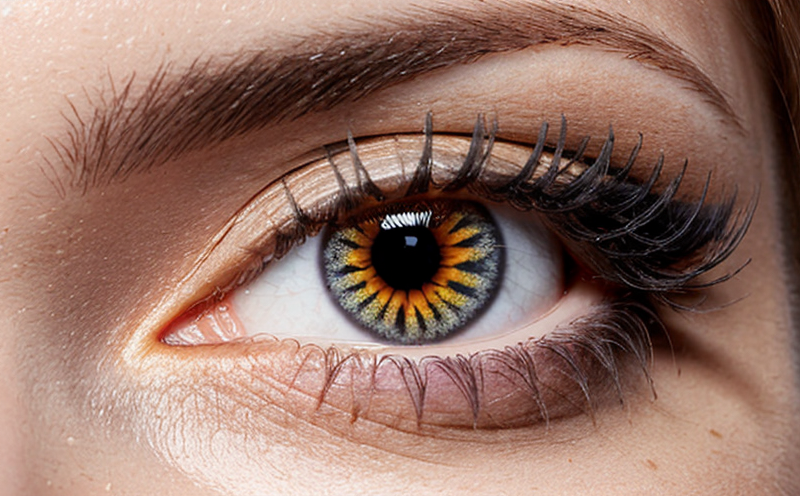Ocular Safety Testing for Colored Contact Lens Solutions
When it comes to colored contact lens solutions, ocular safety testing is more than just a regulatory requirement—it's a commitment to ensuring the health and well-being of end-users. This type of testing plays a crucial role in identifying potential allergens, irritants, and other harmful substances that could cause adverse effects on the eyes.
The process begins with the selection of appropriate specimens for testing. These include lens solutions, preservatives, and any additives used in their formulation. Once selected, these samples undergo rigorous analysis using both chemical and biological methods to evaluate their potential impact on ocular health.
One key aspect of this testing involves examining how the solution interacts with various components of the eye, such as the cornea, conjunctiva, and tear film. This helps in understanding if there are any adverse reactions that could lead to discomfort or injury. Additionally, sensitivity tests may be conducted to assess whether certain ingredients might provoke allergic responses.
For effective ocular safety testing, it's essential to follow internationally recognized standards such as ISO 14972:2019 which provides guidance on the design, evaluation, and control of systems used in healthcare settings that interact with patients. Compliance with these guidelines ensures consistency across different labs worldwide.
The results from ocular safety tests are critical for manufacturers because they provide valuable insights into product quality and performance. They also help in making informed decisions about ingredient selection and formulation adjustments to meet regulatory requirements while enhancing user experience.
- Ensures compliance with international standards
- Identifies potential allergens and irritants
- Evaluates interaction between solutions and eye tissues
- Assesses overall product quality and performance
Scope and Methodology
The methodology for ocular safety testing of colored contact lens solutions typically involves several steps aimed at assessing the biocompatibility and potential adverse effects on the eye. The first step is to prepare the samples according to prescribed protocols, ensuring they are representative of actual usage conditions.
Once prepared, tests are conducted using various pieces of specialized equipment designed specifically for ocular safety evaluations. These might include but are not limited to artificial eyes filled with simulated tears (TEFLON®) and live rabbit corneas. The aim is to mimic real-world scenarios as closely as possible so that the results accurately reflect what could happen during normal wear.
During these tests, various parameters such as pH levels, osmolarity, viscosity, and microbial content are continuously monitored. Changes in these values over time can indicate potential issues with the solution’s stability or ability to maintain a healthy environment around the eye. Furthermore, visual observations of any changes in corneal clarity or conjunctival hyperemia (redness) provide additional insight into the product's safety profile.
At the conclusion of each test series, detailed reports are generated summarizing all findings along with recommendations for improvements where necessary. These reports serve not only as documentation but also as tools for continuous improvement in formulation processes and ultimately contribute to safer products reaching consumers faster.
Environmental and Sustainability Contributions
Incorporating sustainable practices into ocular safety testing can have significant positive impacts on both the environment and society at large. By adopting eco-friendly materials and minimizing waste throughout the testing process, labs contribute to reducing their carbon footprint significantly.
One way this is achieved is by optimizing sample preparation techniques to minimize chemical usage without compromising test accuracy or precision. Reusing disposable items like TEFLON® artificial eyes where appropriate also reduces single-use plastics going into landfills. Moreover, implementing energy-efficient laboratory equipment further supports green initiatives within the facility.
The results of these tests play a vital role in guiding manufacturers towards more sustainable product development cycles. By prioritizing safety early on in the design phase, companies can avoid costly recalls later down the line due to non-compliance issues or poor performance reports from independent third parties. This not only protects brand reputation but also fosters trust among customers who value responsible business practices.
Overall, integrating environmental considerations into ocular safety testing demonstrates a commitment to long-term success by balancing short-term gains with broader societal benefits.
Competitive Advantage and Market Impact
In today’s competitive market, being able to offer ocular safety testing services not only sets your laboratory apart but also enhances its reputation as an industry leader. Here are some key advantages:
- First-to-market products: By providing quick turnaround times for ocular safety tests, you enable clients to bring new innovations to market faster.
- Better decision-making: Accurate test results help manufacturers make informed choices regarding ingredient selection and formulation adjustments.
- Regulatory compliance: Ensuring strict adherence to international standards ensures that your services are trusted by regulatory bodies worldwide, increasing credibility.
- Cost savings: Early identification of issues through testing reduces the likelihood of costly recalls or product failures post-launch.





